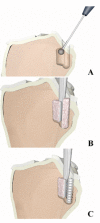Tibial Inlay Press-fit Fixation Versus Interference Screw in Posterior Cruciate Ligament Reconstruction
- PMID: 24416479
- PMCID: PMC3883076
- DOI: 10.4081/or.2013.e35
Tibial Inlay Press-fit Fixation Versus Interference Screw in Posterior Cruciate Ligament Reconstruction
Abstract
Reconstruction of the posterior cruciate ligament (PCL) by a tibial press-fit fixation of the patellar tendon with an accessory bone plug is a promising approach because no foreign materials are required. Until today, there is no data about the biomechanical properties of such press-fit fixations. The aim of this study was to compare the biomechanical qualities of a bone plug tibial inlay technique with the commonly applied interference screw of patellar tendon PCL grafts. Twenty patellar tendons including a bone block were harvested from ten human cadavers. The grafts were implanted into twenty legs of adult German country pigs. In group P, the grafts were attached in a press-fit technique with accessory bone plug. In group S, the grafts were fixed with an interference screw. Each group consisted of 10 specimens. The constructs were biomechanically analyzed in cyclic loading between 60 and 250 N for 500 cycles recording elongation. Finally, ultimate failure load and failure mode were analyzed. Ultimate failure load was 598.6±36.3 N in group P and 653.7±39.8 N in group S (not significant, P>0.05). Elongation during cyclic loading between the 1(st) and the 20(th) cycle was 3.4±0.9 mm for group P and 3.1±1 mm for group S. Between the 20(th) and the 500(th) cycle, elongation was 4.2±2.3 mm in group P and 2.5±0.9 mm in group S (not significant, P>0.05). This is the first study investigating the biomechanical properties of tibial press-fit fixation of the patellar tendon with accessory bone plug in posterior cruciate ligament reconstruction. The implant-free tibial inlay technique shows equal biomechanical characteristics compared to an interference screw fixation. Further in vivo studies are desirable to compare the biological behavior and clinical relevance of this fixation device.
Keywords: biomechanical properties; interference screw; posterior cruciate ligament reconstruction; tibial press-fit fixation.
Conflict of interest statement
Conflict of interests: the authors declare no potential conflict of interests.
Figures



Similar articles
-
Novel press-fit technique of patellar bone plug in anterior cruciate ligament reconstruction is comparable to interference screw fixation.Arch Orthop Trauma Surg. 2022 Aug;142(8):1963-1970. doi: 10.1007/s00402-021-04137-y. Epub 2021 Aug 30. Arch Orthop Trauma Surg. 2022. PMID: 34462826
-
The fixation strength of tibial PCL press-fit reconstructions.Knee Surg Sports Traumatol Arthrosc. 2012 Feb;20(2):308-14. doi: 10.1007/s00167-011-1584-z. Epub 2011 Jun 22. Knee Surg Sports Traumatol Arthrosc. 2012. PMID: 21695464
-
[Implant-free tibial fixations of the posterior cruciate ligament. Development and biomechanical testing].Unfallchirurg. 2013 Jul;116(7):589-95. doi: 10.1007/s00113-012-2167-2. Unfallchirurg. 2013. PMID: 22706648 Clinical Trial. German.
-
[Replacement of the anterior cruciate ligament. Biomechanical studies for patellar and semitendinosus tendon fixation with a poly(D,L-lactide) interference screw].Unfallchirurg. 1999 Feb;102(2):115-23. doi: 10.1007/s001130050382. Unfallchirurg. 1999. PMID: 10098418 German.
-
Press-fit fixation in anterior cruciate ligament reconstruction yields low graft failure and revision rates: a systematic review and meta-analysis.Knee Surg Sports Traumatol Arthrosc. 2021 Jun;29(6):1750-1759. doi: 10.1007/s00167-020-06173-4. Epub 2020 Aug 12. Knee Surg Sports Traumatol Arthrosc. 2021. PMID: 32785757
Cited by
-
CORR Insights®: No Clinically Important Difference in Knee Scores or Instability Between Transtibial and Inlay Techniques for PCL Reconstruction: A Systematic Review.Clin Orthop Relat Res. 2017 Apr;475(4):1249-1251. doi: 10.1007/s11999-016-5206-4. Epub 2017 Jan 30. Clin Orthop Relat Res. 2017. PMID: 28138919 Free PMC article. No abstract available.
-
[The killer turn in the posterior cruciate ligament reconstruction: mechanism and improvement].Zhongguo Xiu Fu Chong Jian Wai Ke Za Zhi. 2020 Jun 15;34(6):787-792. doi: 10.7507/1002-1892.201907066. Zhongguo Xiu Fu Chong Jian Wai Ke Za Zhi. 2020. PMID: 32538573 Free PMC article. Review. Chinese.
References
-
- Shelbourne KD, Clark M, Gray T.Minimum 10-year follow-up of patients after an acute, isolated posterior cruciate ligament injury treated nonoperatively. Am J Sports Med 2013;41:1526-33 - PubMed
-
- Fanelli GC, Beck JD, Edson CJ.Current concepts review: the posterior cruciate ligament. J Knee Surg 2010;23:61-72 - PubMed
-
- Peccin MS, Almeida GJ, Amaro J, et al. Interventions for treating posterior cruciate ligament injuries of the knee in adults. Cochrane database Syst Rev 2005:CD002939 - PubMed
-
- Boynton MD, Tietjens BR.Long-term followup of the untreated isolated posterior cruciate ligament-deficient knee. Am J Sports Med 1996;24:306-10 - PubMed
-
- Amis AA, Gupte CM, Bull AM, Edwards A.Anatomy of the posterior cruciate ligament and the meniscofemoral ligaments. Knee Surg Sports Traumatol Arthrosc 2006;14: 257-63 - PubMed
LinkOut - more resources
Full Text Sources
Other Literature Sources
